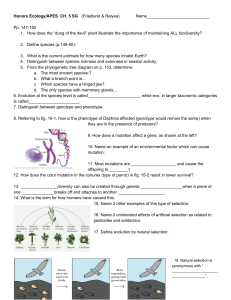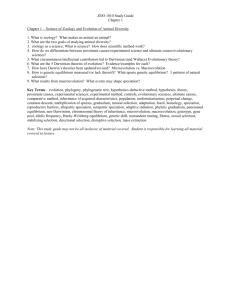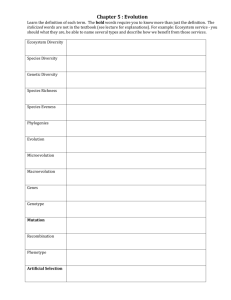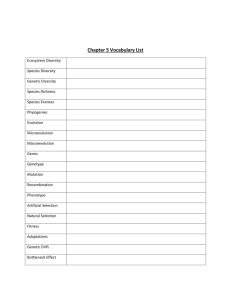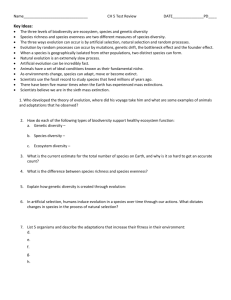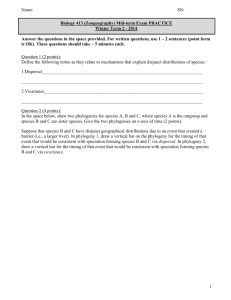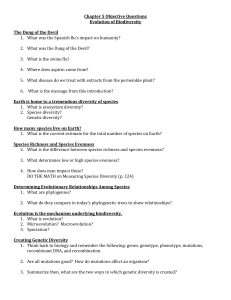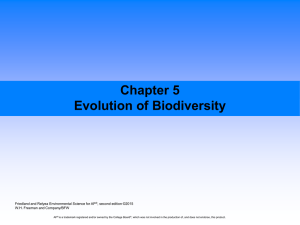Chapter 5 Objectives
advertisement
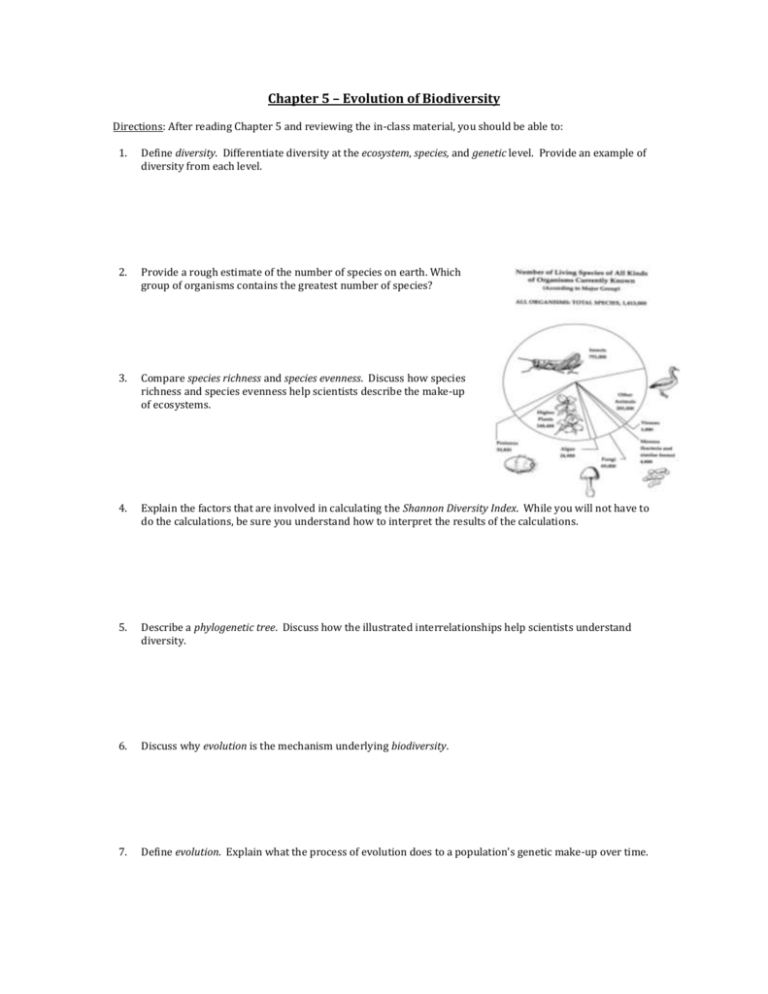
Chapter 5 – Evolution of Biodiversity Directions: After reading Chapter 5 and reviewing the in-class material, you should be able to: 1. Define diversity. Differentiate diversity at the ecosystem, species, and genetic level. Provide an example of diversity from each level. 2. Provide a rough estimate of the number of species on earth. Which group of organisms contains the greatest number of species? 3. Compare species richness and species evenness. Discuss how species richness and species evenness help scientists describe the make-up of ecosystems. 4. Explain the factors that are involved in calculating the Shannon Diversity Index. While you will not have to do the calculations, be sure you understand how to interpret the results of the calculations. 5. Describe a phylogenetic tree. Discuss how the illustrated interrelationships help scientists understand diversity. 6. Discuss why evolution is the mechanism underlying biodiversity. 7. Define evolution. Explain what the process of evolution does to a population’s genetic make-up over time. 8. Define microevolution. Describe antibiotic resistance in bacteria as an example. Use the diagram to describe how resistance is transferred in bacteria. 9. Define macroevolution. Describe the production of new species and how speciation as an example of macroevolution. 10. Define the term genetic diversity. Explain what a gene is, physically, and how mutations occur. Describe how a mutation can be harmful or helpful to an individual. 11. Describe the process of recombination. Identify how recombination can change the genetic make-up of an individual. Fill-in the missing letters on the diagram. 12. Compare and contrast an individual’s genotype with their phenotype. MICROEVOLUTION – genetically distinct populations of the same species 13. Describe the process of evolution by artificial selection. Describe how humans perform artificial selection. 14. Describe the process of evolution by natural selection. Discuss what is meant by the term “natural”. 15. Explain the 5 major components of Darwin’s Theory of Evolution: a. Individuals produce an excess of offspring. b. Not all offspring can survive. c. Individuals differ in their traits. d. Differences in traits can be passed on from parents to offspring. e. Differences in traits are associated with differences in the ability to survive and reproduce. 16. Define (in Darwin’s terms) the meaning of fitness. Discuss how fitness is related to adaptations. 17. Describe each of the four random processes that can cause evolution: a. Mutation b. Genetic drift c. Bottleneck effect d. Founder effect MACROEVOLUTION – new species 18. Define geographic isolation. Discuss how species become geographically isolated. 19. Define reproductive isolation. Discuss how species become reproductively isolated. 20. Define allopatric speciation. Describe how geographic and reproductive isolation can lead to allopatric speciation. Label the diagram to show allopatric speciation. 21. Define sympatric speciation. Describe how polyploidy can cause sympatric speciation. Describe how two fly populations exploiting a new food supply can lead to sympatric speciation. 22. Describe how each of the following four factors can speed up or slow down the pace of evolution: a. Rate of environmental change b. Genetic variation c. Population size d. Generation time. EVOLUTION & ECOLOGICAL NICHES 23. Define range of tolerance. Use the diagram to illustrate the parts of the curve: “survive”, “survive and grow”, and “survive, grow, and reproduce”. 24. Compare an organism’s fundamental niche and its realized niche. Relate niche to the range of tolerance of the organism. 25. Compare species that are niche generalists with those that are niche specialists. 26. Describe how the fossil record helps scientists to understand the process of extinction and speciation. Identify the basic timing of the five recorded mass extinctions. 27. Describe why scientists believe that today we are starting to experience the sixth mass extinction. “Evolution is ecology over time.”

